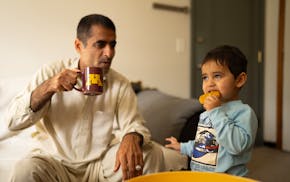Yue Wu reminded her client to relax and asked him to count backward from 20. He did.
But Gabe Sanders, 14, was still a bit fidgety. Wu reached over and turned down the speed of the metronome clicking from the computer on the desk.
"I think you're still a little too excited," Wu said. "Let's take five deep breaths."
Gabe paused to breathe, then launched back into playing composer John Williams' "Theme from 'Schindler's List'" on the baby grand piano in Wu's office at MacPhail Center for Music in Minneapolis.
Wu stopped him again.
"Can you control your hand?" she asked, and he focused on keeping a hand steady. "Yes! You definitely can do it. You just needed some support. All right, you're getting there, try it."
Gabe was getting more than just a piano lesson. The boy, who has a couple of developmental disorders, receives music therapy at MacPhail. Wu, like others in MacPhail's 22-year-old program, is both a musician and a board-certified music therapist.
Gabe continued playing, getting more encouraging feedback from Wu.
"There you go, good job!" she said. "Yes, Gabe, see, you did it! You did this part so well."
Music therapy is an established health specialty that uses music to treat physical, emotional, cognitive and social issues. It works partly by taking advantage of music's special powers to affect brain function, mood and behavior.
Do certain songs conjure memories of where you were when you first heard them? When you listen to music, do you often get the urge to nod your head, tap your feet, snap your fingers or even get up to dance? Are there songs that energize you for a workout and others that relax you for sleep? Does a product slogan like "Save big money at Menards!" instantly bring to mind a particular tune?
If you've experienced those, you've seen the almost magical ways the human brain responds to music.
Music is used to treat stress, pain and depression and improve cognitive and motor skills. In cases of stroke or other brain damage, it can help build new routes in the brain, circumventing the damaged area. U.S. Rep. Gabby Giffords received music therapy to regain her ability to speak after being shot in the head in 2011.
Studies using functional magnetic resonance imaging show that listening or producing music can trigger activity throughout the brain, unlike speech, which is concentrated in specialized areas.
"There's not any population for which we can't use music as a driving force to help gain non-musical goals," said Melissa Wenszell, a board-certified music therapist — one of more than 300 in Minnesota — who co-founded MacPhail's music therapy program in 2002.
It's a vast form of therapy, used in hospitals, assisted living residences, schools, hospices, rehabilitation facilities, correctional facilities, homeless shelters and more. MacPhail's program serves about 700 clients a year with a wide range of needs.
Music therapy can include singing, playing an instrument, moving to music or even just listening. It can encompass any kind of music: rock, jazz, country, rap, even music from other cultures.
"People sometimes say, what's the most relaxing music?" Wenszell said. "Well, it's whatever is most relaxing for you. A lot of times people think [it's] classical music. That's lovely and beautiful, but that might not be what actually decreases someone's cortisol and increases their serotonin. And so you have to use the music someone enjoys to heighten that arousal level because music is a whole brain experience."
A way to improved speech
Carrie Schwert of Edina has watched how music therapy has helped her daughter, Emma, who was diagnosed with autism at age 3. She started music therapy at 5 while attending Fraser, a school for students with disabilities.
"Emma hardly spoke at that point," Schwert said. "Just a word or two here and there. Plus, she had a stutter."
Emma started attending music therapy sessions at MacPhail while she was in middle school. Now 27, Emma "can have good conversations with good vocabulary, and her speech is very fine," her mother said. Emma became involved in musical theater and can sing solo onstage before a full auditorium without stage fright.
"Music became her passion, as really her doorway into speech," Schwert said. "It was really the way she began enjoying speaking. ... She's learned to regulate her emotions, she's able to express herself. She enjoys it, and it's given her confidence."
Wu's next clients after Gabe, sisters Lily and Bethany Maetzold, have shown improvement after just a year of music therapy, said their mother, Pat of White Bear Lake. The girls, 13 and 14 respectively, have disabilities that include attention disorder. In their session with Wu, the girls played drums to work on paying attention and following directions.
"What it does is really to prolong the attention span so a child can sit through a class and can learn things in school instead of wandering around," Wu said.
With a drum of her own, Wu beat in rhythms alternating fast and slow, instructing them to follow her tempo and stop when she said "stop."
"It's been a lot of fun to watch and see from a developmental and rehabilitation standpoint, putting all those pieces together in a way that's meaningful to the girls," said Pat, who'd signed them up after hearing about the benefits of music therapy.
"To them, they're just making some music; to everybody else, they're making huge gains in their coordination."
Starting in the womb
Music's effects, especially rhythm, could be related to humans' exposure in utero, where brain and body development are accompanied by sounds of the mother's heartbeat and breathing,
"So the very basic areas of your brain are first formed while processing that rhythm," Wenszell said. "It's actually quite loud in there."
Wenszell wrote her thesis based on her previous role as a therapist in a neonatal intensive care unit where she had observed music comforting newborns with intestinal pain.
"You would start playing soft guitar, and because they're on the monitor, you see that normalization," she said. "You see their respiration change. You see their [blood oxygen] level increase. You see them ease more into an actual sleep and stay there for longer periods of time because their system is soothed. Instead of being, 'I'm in pain and discomfort and anxiety and I don't like all this,' they're like, 'Oh, well, maybe that's better.'"
Combined with deep breathing, music can work the same way for adults experiencing pain or anxiety, she said.
Music can generate endorphins, neurotransmitters that improve mood and enhance a sense of well-being. That's how MacPhail provides therapy at Andrew Residence, a residential facility for adults with mental illness. It's one of MacPhail's community partners, where residents gather weekly to sing.
"If you can just imagine, a group of adults that all have pervasive and and chronic mental health disorders, singing 'Don't Stop Believing' at the top of their lungs," Wenszell said.
Wenszell recalled being approached recently by a new resident who wanted to share his feelings about the program.
"He's like, 'I have to tell you. I'm shaking right now because I'm having so much joy and I had so much fun,'" Wenszell said.
The man told her he hadn't felt that way for years. "The energy and the music, I almost don't know what to do with it," she recalled.
"I just feel so good," the man said.

Broders won't reopen Terzo restaurant in Minneapolis after flooding

Afghan allies struggle in Minnesota after funding cuts: 'What will I do?

Never mind the oldies — here are 10 younger acts to see this summer in Minnesota

The 5 best things our food writers ate this week

